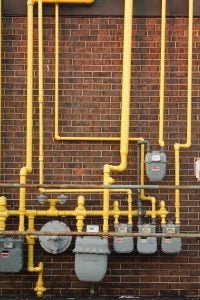 SoCalGas – the nation’s largest gas utility recently pledged to go net-zero on their greenhouse gas emissions. At face value, this is a great move, but what does this really mean for a gas-only company that has had some major climate missteps in the past? And what are the implications for current and future SoCalGas customers?
SoCalGas – the nation’s largest gas utility recently pledged to go net-zero on their greenhouse gas emissions. At face value, this is a great move, but what does this really mean for a gas-only company that has had some major climate missteps in the past? And what are the implications for current and future SoCalGas customers?
Today, customers use natural gas for a variety of purposes — to warm our homes, to take hot showers, to cook hot meals. But as part of the transition to a cleaner energy economy, more and more customers are shifting to electric appliances to perform those same functions. That shift means that they will be leaving the gas system to a decarbonized electric grid.
That’s great news for the climate, but it’s less great news if you’re a gas-only company or if you’re one of the few gas customers left on the system, especially if you are a large industrial customer and there is not an electric alternative available for your business process.
Here’s the challenge: Gas pipelines are expensive and they are built to last a long time — 50 to 60 years. So if there are fewer gas customers, it means there will be fewer people left to pay for those pipeline investments. According to E3 and Gridworks, if the transition away from gas is not properly managed, it could cause customer gas bills to shoot up by 500%.
What does it really mean for a gas utility to go net-zero? Share on XThe good news here is that this unaffordable rate increase can be avoided if we start planning for decommissioning this infrastructure now. Part of that vision requires gas utilities to set out a vision for how they plan to participate in the transition. Long-term infrastructure planning has often been done in the electricity space, but rarely is it done in gas planning; new gas lines are generally authorized without a master plan guiding their development.
Historically, California has not required gas utilities like SoCalGas to express a long-term vision of where their business is headed. But with this recent announcement, that is exactly what SoCalGas is doing.
This vision encompasses both the energy delivered to customers and its own operational footprint. As the largest gas distribution company in the country, this vision will be transformative to ensure that customers receive affordable, clean and safe energy service. It will be up to the California regulators to ensure that the implementation of this vision is not based on wishful thinking, but rather on what is in the best of interest of their customers and the environment.
The vision document is light on details, but that is what the development of a long-term plan is for. It is far easier to establish a shared vision of what the right mix of solutions like non-pipeline alternatives, future infrastructure investments and zero-carbon fuels are with a starting point document like this in hand.
However, one of the key items missing in the SoCalGas vision is an adequate discussion about the total cost to achieve the vision, the impact on customer rates and how the company will protect its low income residential customers. Further, as residential customers leave the system, there will be a need to manage the cost shifts in a prudent fashion so that the remaining customers are not left with unreasonable bills. These should be core principles headed into the California long-term gas planning process.
SoCalGas is not alone in this long-term gas planning. A number of other states, including Massachusetts, New York and New Jersey are also engaged in long term planning dockets with their gas utilities in an effort to align gas planning with emerging climate goals. Below are a handful of resources that can aid in the planning for the energy transition:
- EDF Report: Aligning Gas Regulation and Climate Goals
- Gridworks Report: Gas Resources and Infrastructure Planning for California
- Study: California needs clean firm power and so does the rest of the world
- EDF Whitepaper: Managing the Transition: Proactive Solutions for Stranded Gas Asset Risk in California
As EDF has argued for several years now, there should be a way to align shareholder value with prudent management of the decarbonization transformation. That in turn saves its customers money and advances the state’s policy decarbonization agenda. This public commitment from SoCalGas will help EDF and other advocates hold them accountable in long term planning.









